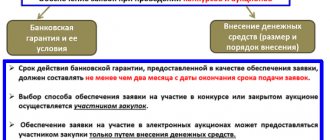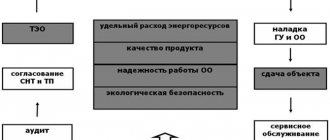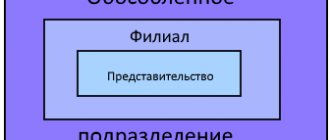The concept of a security deposit is described in Art. 381.1 of the Civil Code of the Russian Federation. It always has a monetary value, but its role can be played not only by banknotes, but also by securities and bonds. The rules of civil law provide for exceptional cases when the security payment made can be returned.
Question: A premises rental agreement has been concluded between the organizations. According to the agreement, the tenant makes a security deposit to compensate for expenses upon termination of the lease agreement. Subsequently, the lease agreement is terminated and the lessor counts the amount of the security deposit towards compensation for utility costs. Should the lessor use cash register when accepting the amount of the security deposit, as well as when offset against expenses? View answer
What is a security deposit?
In a broad sense, a security payment is an amount of money that the obligated party to the contract transfers to the authorized party in order to ensure the fulfillment of its obligations under the relevant contract or to compensate for possible losses of the authorized party.
In this context, a security payment can be placed on a par with a pledge, a deposit and other security mechanisms (clause 1 of Article 329 of the Civil Code of the Russian Federation, letter of the Ministry of Finance dated March 24, 2017 No. 03-03-07/17197). In the narrow sense, in accordance with the provisions of paragraph 1 of Art. 381.1 of the Civil Code of the Russian Federation, a security payment should be understood as a sum of money that is transferred by the obligated party to the contract to the authorized party in order to secure a monetary obligation.
Moreover, such an obligation may arise in the future, and its fulfillment (in whole or in part) through the security payment is carried out when the circumstances established by the contract arise. If such circumstances do not occur (or if the obligated party fulfills the terms of the agreement), then the amount of the security payment is returned to the obligated party, unless otherwise provided by the agreement (Clause 2 of Article 381.1 of the Civil Code of the Russian Federation).
Separate agreements between the parties may regulate the replenishment or, conversely, partial return of the security deposit amounts under certain circumstances.
Let us study how accounting is carried out for transactions reflecting the transfer of amounts of money on account of a security deposit from the obligated party to the contract to the authorized party. Records will be kept by both parties to the legal relationship.
At the same time, accounting for the simplified tax system and the operating tax system will differ.
The need to tax the amount of the security deposit
Important!
If the text of the agreement between the parties states that the amount of the security payment can be used by the recipient in settlements of the main obligation upon termination of the agreement, the security payment is considered as an advance. Accordingly, the need arises to pay personal income tax and VAT (and the company generates income using the simplified tax system).
If the agreement does not provide for settlements under the main obligation upon termination of the agreement using a security payment, then this payment cannot be regarded as income of the recipient of the funds. A security payment is not income until some event occurs, upon the occurrence of which the obligations will be secured by the amount of the security payment. If nothing like this happens, the money is returned to the payer. It turns out that the party to the contract who received the payment is its temporary holder who has no commercial benefit.
How to calculate a security payment under the simplified tax system: entries in the accounting of the authorized party
First, let's look at how the authorized party (for example, the seller of goods) reflects information about the security payment regarding the receipt of monetary compensation in accounting entries.
Example 1
Trading-Consulting LLC, as a supplier of vegetables, entered into an agreement with Leasing-Banking LLC. According to the agreement, the buyer of vegetables made a security payment. Trading-Consulting LLC successfully supplied vegetables, and Leasing-Banking LLC paid for the delivery on time. The vegetable supplier returned the security deposit to the buyer because the latter fulfilled the obligations established by the contract.
In the specified legal relationship with the use of a security payment, the accounting entries under the simplified tax system will be as follows:
- Dt 51 Kt 62/OP (now and in all cases further, unless otherwise indicated, subaccount for the counterparty, in this case Trading-Consulting LLC) - receipt of payment;
- Dt 62 Kt 51 - return of payment to the counterparty.
Example 2
Trading-Consulting LLC, as a supplier of vegetables, entered into an agreement with Vending-Lending LLC. The buyer made a security deposit. Trading-Consulting LLC supplied vegetables, but Vending-Lending LLC did not pay for the supplies due to financial difficulties. The security payment was not returned to the buyer and offset against its obligations to the supplier.
In this scenario, the following postings will be applied:
- Dt 51 Kt 62/OP - receipt of payment;
- Dt 62/OP Kt 62 - the security payment is counted as payment for supplies;
- Dt 62 Kt 90.1 - credited OP is included in revenue (“on payment” for the simplified tax system).
Now - about the postings used by the obligated party.
Security payment. Now it's official
It turns into part of the payment already made by the tenant as repayment:
- debts on future rent payments of the last month of the lease - in case of proper fulfillment by the tenant of his obligations;
- possible penalty (fine) - in case of termination of the contract for reasons due to the fault of the tenant.
Thus, while the deposit is security, there are no obligations in accounting that this deposit secures, and when obligations appear in accounting, then the deposit is no longer security, but turns into part of the payment of either rent or a fine (penalty) for termination of an agreement.
In all such situations, accounting practice follows the path of recognizing directly on-balance sheet items and non-recognizing off-balance sheet collateral for unrecognized liabilities. The very fact of the presence of a security payment does not lead to an outflow of economic benefits from the lessee if he/she properly fulfills the contract. The fact of termination of the contract leads to an additional outflow of economic benefits from the tenant (in the form of a penalty in the amount of the paid security deposit):
- at the initiative of the tenant (if, under the terms of the contract, the tenant has the right to terminate the contract at any time, but with a fine in the amount of the paid security deposit);
- in case of improper fulfillment by the tenant of the terms of the contract.
According to Art.
330 of the Civil Code of the Russian Federation, a penalty (fine, penalty) is a sum of money determined by law or contract, which the debtor is obliged to pay to the creditor in the event of non-fulfillment or improper fulfillment of an obligation, in particular in the case of delay in fulfillment. A penalty does not in any way guarantee the fulfillment of an obligation by certain property, but simply increases this very obligation in case of violation of the terms of its fulfillment.
The amount of the security payment transferred to the lessor as security for the tenant’s compliance with its obligations under the agreement is not recognized as an expense at the time of payment and is not recognized as an issued security for obligations (account 009 “Securities for obligations and payments issued”), but is reflected in the accounting records of the lessee as part of the accounts receivable debt (clause 3, 16 PBU 10/99 <1>) as an advance payment:
D 76 “Settlements with various debtors and creditors” (60 “Settlements with suppliers and contractors”), analytical attribute “Landlord, advances issued”, - K 51 “Settlement accounts” - funds were transferred to the lessor (security payment).
<1> The accounting regulation “Expenses of the organization” PBU 10/99 was approved by Order of the Ministry of Finance of Russia dated May 6, 1999 N 33n.
When a case of termination of the contract occurs (at the initiative of the lessor due to late payment of rent, at the initiative of the lessor for repeated violation of the terms of the agreement by the tenant, or at the initiative of the tenant), the tenant recognizes in accounting the amount of the security payment as expenses of the current period as a penalty (fine) for termination of the contract and at the same time the advance payment issued is offset against payment of the recognized penalty (fine):
D 76 (60), analytical attribute “Landlord”, - K 76 (60), analytical attribute “Landlord, advances issued” - the advance payment for the last month’s rent is offset against the penalty (fine);
D 91 “Other income and expenses”, analytical indicator “Other expenses” (90 “Sales”, analytical indicator “Expenses for ordinary activities”) - K 76 (60), analytical indicator “Lessor” - recognized as an expense the amount of the penalty (fine) in case of early termination of the contract.
When returning funds to the tenant in the form of a security payment upon termination of the contract on the basis of the contract (if the premises leased, due to circumstances for which the tenant is not responsible, turned out to be in a condition unsuitable for use; if, due to the fault of the landlord, maintenance services are not provided building) the tenant reflects in the accounting records the receipt of funds in the form of return of advances issued:
D 51 - K 76 (60), analytical attribute “Lessor, advances issued” - reflects the return by the lessor to the lessee of funds transferred to the lessor as a security payment.
If the amounts of the security payment are significant, the lessee must disclose information in the notes to the financial statements regarding the amount, function of the security payment and the conditions of its non-refundability.
N.S.Fresorger
Senior manager
accounting consulting department
I.D.Yutskovskaya
Director
accounting consulting department
Home»» Forums of the Chamber of Tax Consultants »» Forum for practicing specialists
To create new forum topics, you must log in to the site. Registration is not required to answer. We ask you to leave your names so that forum participants can contact you.
Accounting for a security payment by the obligated party under the simplified tax system: entries
Leasing-Banking LLC, within the framework of the agreement on the application of a security deposit, will select the following entries in the accounting registers:
- Dt 60/OP (subaccount again for the counterparty) Kt 51 - payment transferred to the counterparty;
- Dt 51 Kt 60/OP - the counterparty returned the payment.
Vending-Lending LLC will record the following entries in its registers:
- Dt 60/OP Kt 51 - payment transferred to the counterparty;
- Dt 41 Kt 60 - goods supplied by the counterparty are accepted onto the balance sheet;
- Dt 60 Kt 60/OP - payment is credited as payment for supplies.
IMPORTANT! As an alternative to accounts 60 (when accounting for transactions with a supplier) and 62 (when accounting for transactions with a buyer), account 76 can be used for OP. In this case, it also makes sense to open a subaccount for the counterparty.
Postings are used according to a different scheme if the parties work on OSN. This is mainly due to the fact that they become VAT payers.
OSN: postings of the authorized party for a security payment including VAT
Trading-Consulting LLC, if it is agreed that it works on the OSN, can apply postings with the allocation of VAT. This must be done if the payment is applied in practice, that is, counted as payment for supplies (letter from the Department of Tax and Customs Tariff Policy of the Ministry of Finance of Russia dated November 3, 2015).
When interacting with Leasing-Banking LLC, there will be no reason to calculate VAT. But in the course of cooperation with Vending-Lending LLC, the tax will be allocated. In this case, the vegetable seller will use the following entries:
Subscribe to our newsletter
Yandex.Zen VKontakte Telegram
- Dt 51 Kt 62 (76)/OP - payment accepted;
- Dt 62(76)/OP Kt 62 - payment is credited as payment for the goods;
- Dt 62 Kt 90.1 - revenue for the goods is reflected (in the amount of the offset security payment);
- Dt 90.3 Kt 68 - VAT is charged on the amount of revenue.
In turn, the buyer of goods on the OCH will also apply separate postings.
Reflection of leasing transactions by the Lessee when accounting for property on the lessee’s balance sheet
Accounting
The initial cost of leased property in accounting is recognized as the sum of all payments under the leasing agreement (security payment, preliminary payments, leasing payments, redemption value).
The useful life is equal to the term of the contract. When calculating depreciation, it is possible to use a multiplying factor up to 3 inclusive.
The property purchased at the end of the contract term is accepted as a new fixed asset or inventory, depending on the value of the redemption value.
Table 1 - Typical entries for leasing transactions*
| Contents of operation | Debit | Credit |
| Accounting for leased property | ||
| Received property from the lessor | 08 | 76-L/AO |
| The total amount of VAT under the agreement is reflected | 19 | 76-L/AO |
| Leased property is included in the fixed assets | 01-L | 08 |
| Depreciation accrued on leased property | 20 (25,26,44) | 02-L |
| The cost of depreciated leased property was written off at the end of the contract | 02-L | 01-L |
| Property received at redemption price | 10 (08) | 76-L/V |
| The property was accepted for accounting at the redemption value | 01 | 08 |
| Accounting for security deposit | ||
| Security payment transferred | 76-L/A | 51 |
| VAT reflected on the security deposit | 19 | 76-L/A |
| Accepted for deduction of VAT from the security deposit | 68 | 19 |
| Security deposit credited | 76-L/TP | 76-L/A |
| Recovered VAT from advance payment | 76-L/TP | 68 |
| Accounting for leasing payments | ||
| Lease payment paid | 76-L/TP | 51 |
| Lease payment accrued | 76-L/AO | 76-L/TP |
| Accepted for deduction of VAT on leasing payment | 68 | 19 |
| Accounting for redemption value | ||
| Redemption price paid | 76-L/V | 51 |
| VAT is reflected on the redemption price | 19 | 76-L/V |
| Accepted for deduction of VAT from the redemption price | 68 | 19 |
| Property received at redemption price | 10 (08) | 76-L/V |
| The property was accepted for accounting at the redemption value | 01 | 08 |
Tax accounting
The initial cost of leased property in tax accounting is the price of its acquisition, which is specified in the leasing agreement (the cost of the leased asset).
The useful life is determined according to general rules (in accordance with OKOF). If the property belongs to the fourth to tenth depreciation groups, then accelerated depreciation can be charged with an increasing factor of up to 3 inclusive.
Leasing payments are included in other expenses on a monthly basis. In this case, the amount of such expense is determined as the difference between the accrued lease payment and accrued depreciation (for the current month). If the calculation results in a negative value, then the lease payment is not taken into account in expenses.
It is necessary to ensure that the total amount of expenses recognized by you does not exceed the total amount of payments provided for in the agreement. In case of such an excess, it is necessary to stop recognizing lease payments as expenses.
Important: the leasing company is exempt from the obligation to issue monthly certificates of services rendered, so you can accept expenses for accounting based on accrual schedules, offset of advance payments and received invoices.
The redemption value can be taken into account only after the expiration of the lease agreement and the transfer of ownership of the leased property to your organization. There are two options for attributing the redemption value to expenses:
- if it is less than or equal to 100,000 rubles. - one-time as material expenses;
- if it is more than 100,000 rubles. - as the cost of purchasing a new OS object. In this case, the asset is accepted for accounting; according to the general rules, its useful life is established and depreciation is calculated.
You can fully deduct VAT on lessor invoices in the periods in which they are received. In this case, the lessor issues two types of invoices: for advance payment and for sale.
The first type of invoice is issued for the security payment (if it is not credited as a lump sum in the month of payment) and the difference between the accrued and actually paid lease payment (if it is negative). At its discretion, the lessee may not accept such invoices for accounting. However, if you have deducted VAT on the basis of an advance invoice, this VAT will need to be restored in the period when the security payment is credited and the leasing payment is accrued.
Invoices for sales are issued by the lessor in accordance with the schedule for calculating lease payments and offsetting the advance payment. An invoice for the surrender value is issued at the end of the lease agreement. Such documents are accepted by the lessee in accordance with the general procedure.
Obligated party in case of OSN: postings on security deposit
In this case, it does not fundamentally matter whether the security deposit was used to pay for supplies or not. The obligated party - both Leasing-Banking LLC, which returned its security payment, and Vending-Lending LLC, which was forced to pay for vegetables through a security payment - will only deal with input VAT on the goods.
For these purposes, both companies will use the following postings:
- Dt 60 (76)/OP Kt 51 - security payment issued to the counterparty;
- Dt 41 Kt 60 - goods are placed on the balance sheet (amount excluding VAT);
- Dt 19 Kt 60 - VAT presented by the counterparty is taken into account (at the established rate on the cost of goods);
- Dt 60 Kt 60(76)/OP - the security payment is counted as payment for the goods;
- Dt 68 Kt 19 - previously recorded input VAT from the counterparty is accepted for deduction.
It is noteworthy that the transactions considered when applying a security payment by counterparties are very similar to those that characterize the use of another security payment instrument - a deposit.
Earnest money is a sum of money transferred by the buyer to the seller to guarantee the transaction. If the deal fails due to the fault of the buyer, then the seller keeps the deposit, and if he is to blame, he returns to the buyer an amount twice the deposit (clause 2 of Article 381 of the Tax Code of the Russian Federation). If this legal structure is not applied in the contract, then the deposit is considered an ordinary advance, that is, part of the prepayment for the supply (clause 3 of Article 380 of the Tax Code of the Russian Federation).
Let's study what transactions are used when making a deposit and how they differ from those discussed above.
Security deposit under the lease agreement
print version
Hello! The organization entered into a lease agreement with a shopping center. According to the lease agreement, the tenant is obliged to transfer to the lessor's account a security deposit - a security deposit, which is returned in the event of termination of the agreement in full. According to the terms of the agreement, in the event of late rental payments and in a number of other cases, the lessor has the right to satisfy his claims at the expense of the amount of the specified deposit.
Question: 1) does the amount of the deposit made by the tenant underestimate the tax base for income tax?
2) what accounting entries need to be made for this operation?
Thank you,
Anna
Comments:
| Olga (certified tax consultant) (18.12.2014 15:23) |
| Anna. For profit tax purposes, the amount of the security deposit is not included in the tenant's expenses both if he uses the accrual method (clause 14 of Article 270 of the Tax Code of the Russian Federation) and in the case of using the cash method (clause 3 of Article 273 of the Tax Code of the Russian Federation). The amount of the transferred security deposit must be reflected by the tenant in the debit of account 76 “Settlements with various debtors and creditors” in correspondence with the credit of account 51 “Current account” on the date of the bank statement. |
| Reply to comment / Link |
| Elena (03.07.2013 11:18) |
| What documents must be provided to the tenant when making a security payment? Do I need an invoice and invoice? |
| Reply to comment / Link |
| Natalia (25.09.2009 00:52) |
| Good afternoon I am forced to terminate the lease agreement for the retail space before its expiration date. The contract states that in case of early termination, we are obliged to notify 2 months in advance + the security deposit, which is the amount of 2 months' rent, will not be returned to us. Please tell me, from a legal point of view, whether our landlord has the right not to return the amount of the security deposit to us in the event of early termination of the lease agreement, despite the fact that we have no arrears in payment and no damage to the rented premises has been identified. Is the concept of a security deposit legal? |
| Reply to comment / Link |
| Marina (12.05.2017 15:21) |
| postings from the landlord, if the tenant terminated the contract early, how to write off the security deposit. What kind of wiring |
| Reply to comment / Link |
| Catherine (19.06.2009 19:42) |
| Good afternoon Our company is forced to terminate the office lease agreement before its expiration date. The contract states that in case of early termination, we are obliged to notify 2 months in advance + the security deposit, which is the amount of 2 months' rent, will not be returned to us. Please tell me, from a legal point of view, whether our landlord has the right not to return the amount of the security deposit to us in the event of early termination of the lease agreement, despite the fact that we have no arrears in payment and no damage to the rented premises has been identified. Thank you in advance, Ekaterina |
| Reply to comment / Link |
| Galina (19.05.2009 22:49) |
| 1. The security deposit can be considered as a deposit. After all, a deposit is an amount given by one of the contracting parties in payment of payments due from it under the contract to the other party. The deposit serves as proof of the conclusion of the contract and as security for its execution (clause |
Postings for a security deposit and a deposit: comparison
The main practical differences between a deposit and a security deposit:
- The possibility of withholding the amount of the deposit by the supplier who did not deliver anything in fact.
If such withholding occurs, the supplier reflects this fact with postings (let’s agree that the supplier pays VAT):
- Dt 51 Kt 62/Z - deposit received;
- Dt 62/Z Kt 91 - the deposit is included in other income;
- Dt 91 Kt 68 - VAT is charged on the amount of the deposit.
Thus, the postings do not contain the subject of payment (goods) and the fact that VAT has been charged on it: the amount of the deposit is included in other income, and not in revenue (as with a security deposit). Otherwise, the postings are used with the same synthetic accounts as when reflecting the application of the security deposit in accounting.
- Possibility for the buyer to receive double the amount of the deposit.
In such a situation, the buyer will use the following entries:
- Dt 60(76) Kt 51 - the deposit is transferred to the supplier;
- Dt 51 Kt 60(76) - the deposit was received back with a “penalty” amount;
- Dt 60(76) Kt 91.1 - “penalty” excess over the initial deposit is included in other income.
Here again we are talking about the appearance of the amount included in other income, separated from the one that corresponds to the original amount of the deposit that is returned. It is noteworthy that, as in the case of an unused security deposit, VAT is not reflected in the transactions, since the additional income of the buyer in this case is represented by a penalty that is not related to payment for goods (Resolution of the Presidium of the Supreme Arbitration Court of the Russian Federation dated 05.02.2008 No. 11144/07 on case No. A55-3867/2006-22).
Another noteworthy nuance is the use of supporting documents as part of the accounting of the payment in question.
Security payment in accounting: we use supporting documents
When reflecting the offset as payment for the goods of the security payment in accounting, a special supporting document is used - an act of agreement of the parties to make the appropriate offset. The act can reflect:
- information about the agreement under which the security payment is applied;
- information about the reasons for applying the security payment (for example, about the occurrence of financial difficulties with the obligated party when making regular payment);
- the fact that the document is drawn up on the basis of the provisions of Art. 381.1 Civil Code of the Russian Federation;
- the fact that the document is used as an instrument guaranteeing payment (and therefore does not imply the calculation of VAT on the security deposit by default, but only when it is subsequently offset against payment for goods).
The procedure for drawing up the act in question may be provided for by the provisions of the agreement itself.
Otherwise, regarding the use of supporting documents, everything is quite standard: in necessary cases, the contract itself, accounting statements, bills, invoices are used as such (you must remember that VAT payers do not issue them to counterparties who do not themselves pay this tax) .
It will also be useful to familiarize yourself with the nuances of tax accounting for the payment in question.
Procedure for accounting for a tenant's security deposit under a lease agreement
1 tbsp. 380 Civil Code of the Russian Federation). Thus, the security deposit is not recognized as an expense in accounting and tax accounting on the basis of clause 3 of PBU 10/99 “Expenses of the organization” and clause 32 of Art. 270 of the Tax Code of the Russian Federation, respectively. 2. In the tenant’s accounting, the entries will be as follows: Debit 76, subaccount “Security Deposit”, Credit 51
Reply to comment / Linkwebsite creation website developmentNatasha Breen food photographer and food stylistOnline shop of handmade wooden kitchen utensil for food photographersPhoto and video shooting | Website development
Tax accounting of a security payment: nuances
When maintaining tax records of a security payment, you need to keep in mind that:
- The payment received by the supplier is included in his income (and the buyer’s expenses) only upon offset as payment for the goods (letter of the Ministry of Finance of Russia dated March 24, 2017 No. 03-03-07/17197).
The supporting document here is the act that we mentioned above.
- The contract may provide that the security deposit is not returned to the buyer until the end of the entire contract. For example, if several deliveries are planned over several periods. Payment made before the first delivery performs a guarantee function for subsequent deliveries. At the same time, it remains a security payment until it is used in calculations (it does not fall into the tax base for VAT and income).
In practice, this function can be performed:
- according to the situation - when the buyer, due to circumstances, may not have the funds to pay for all deliveries on time;
- when circumstances stipulated by the contract arise (for example, when the contract stipulates that deliveries in an amount exceeding the established amount must be accompanied by a mandatory offset of the security deposit).
Accordingly, the payment is included in the income (expenses) of the party in the reporting period in which the act of offsetting the payment was drawn up (depending on the situation or in a contractual manner).
Common mistakes
Error:
The recipient of the security payment paid personal income tax to the budget at a rate of 13% on the amount of funds he received. The security payment was not subject to use in settlements of the main obligation upon termination of the agreement.
A comment:
A security payment is not income of a party to the agreement until the occurrence of an event that requires the use of this money, which means that the payment is not subject to personal income tax. There is no need to transfer personal income tax to the budget.
***
How to accrue a security payment using accounting entries and how to keep tax records of transactions for the payment in question depends on the status of the party to the agreement (it can be entitled or obligated), the tax regime, and the results of the transaction. If a security deposit is applied in practice to pay for supplies, then the recipient of the payment, who is a VAT payer, must accrue and pay VAT and reflect it in accounting.
You can find more complete information on the topic in ConsultantPlus. Free trial access to the system for 2 days.







